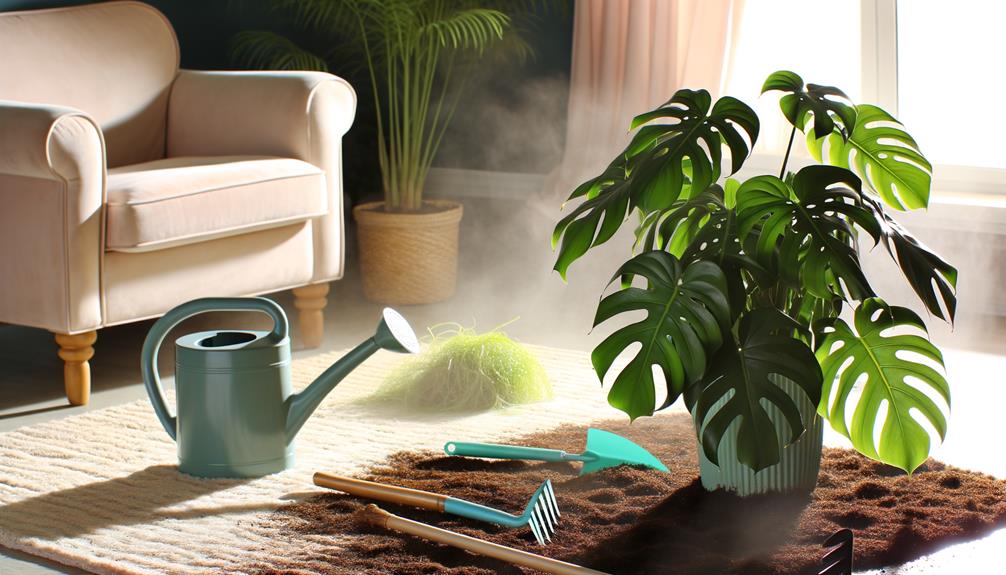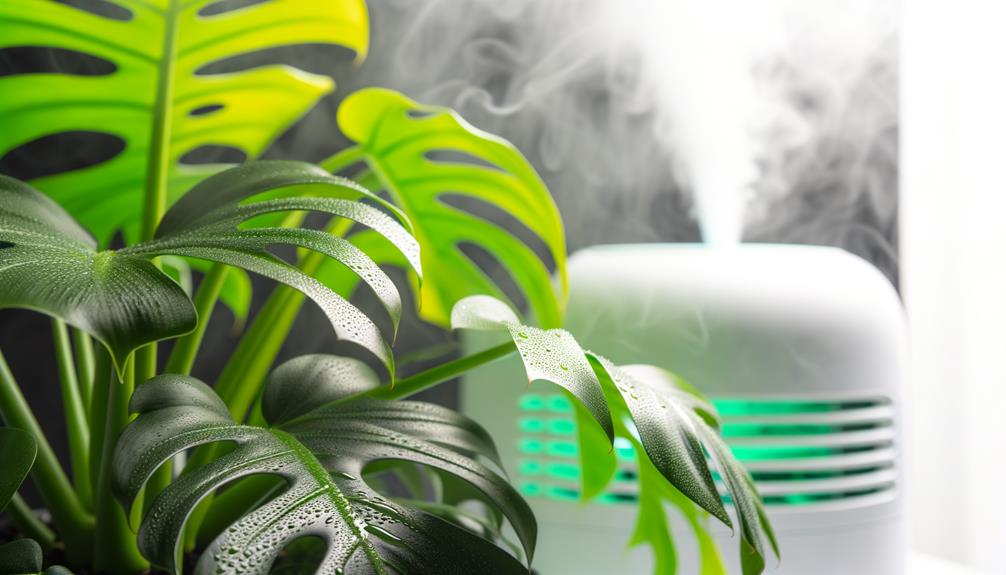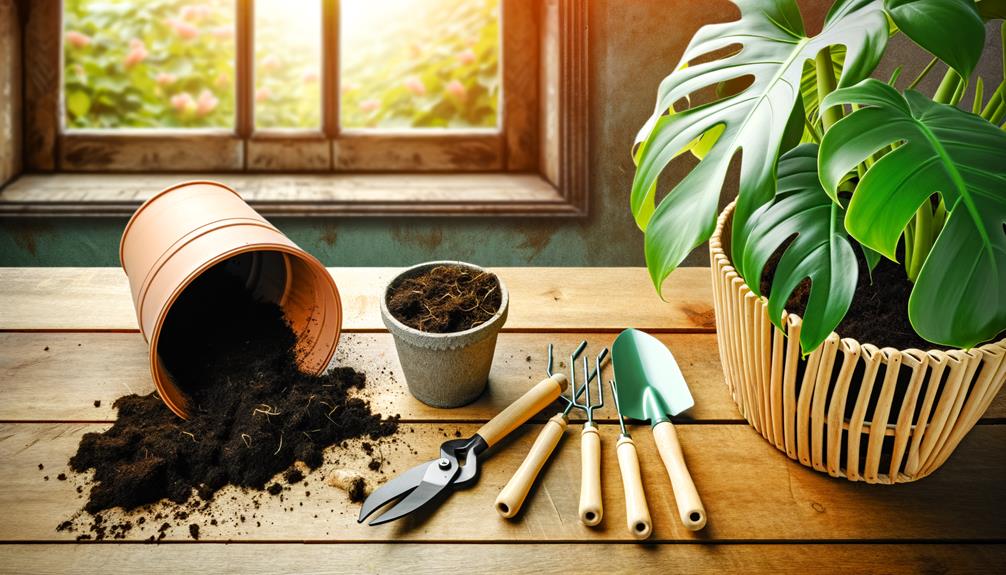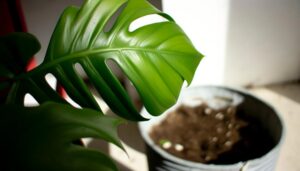How to Encourage New Leaf Growth in Monstera Deliciosa
To foster new leaf growth in Monstera Deliciosa, provide bright, indirect sunlight of 10,000 to 20,000 lux. Keep the soil consistently moist but not waterlogged, allowing the top 2-3 inches to dry between watering.
Maintain a humidity level between 60-80% using a humidifier or regular misting. Utilize nutrient-rich soil enriched with organic matter and a balanced N-P-K fertilizer applied bi-weekly or monthly.
Regular pruning of yellowing or damaged leaves will stimulate growth. Guarantee stable temperatures and clean leaves with a damp cloth to promote photosynthesis.
For those interested, additional intricacies in care can further enhance growth.

Key Takeaways
- Provide bright, indirect sunlight to ensure optimal light conditions.
- Maintain consistent soil moisture and water when the top 2-3 inches are dry.
- Enrich soil with organic matter and ensure proper aeration for healthy roots.
- Apply a balanced N-P-K fertilizer bi-weekly or monthly to support growth.
- Prune yellowing or damaged leaves to encourage new growth and enhance airflow.
Proper Lighting

Ensuring Monstera Deliciosa receives sufficient indirect sunlight is essential for promoting healthy new leaf growth. This tropical plant thrives best in bright, filtered light, mimicking its native understory habitat.
Direct sunlight may scorch its leaves, while insufficient light can stunt growth and lead to smaller, less vibrant foliage. Place the plant near east or west-facing windows, ensuring that it is shielded by sheer curtains or positioned slightly away from the direct rays.
For ideal growth, aim for approximately 10,000 to 20,000 lux of light. Utilizing a light meter can help achieve precise measurements. If natural light is inadequate, consider supplementing with full-spectrum grow lights, ensuring they remain 12 to 18 inches above the plant to prevent overheating.
Ideal Watering Routine
In addition to proper lighting, maintaining an ideal watering routine is fundamental for encouraging new leaf growth in Monstera Deliciosa.
This tropical plant thrives in consistently moist, but not waterlogged, soil. It is advisable to water when the top 2-3 inches of soil feel dry to the touch. Utilize a pot with adequate drainage to prevent root rot, a common issue in overwatered Monsteras.
Employing room-temperature, dechlorinated water can further enhance plant health. During the growing season, typically spring and summer, more frequent watering may be necessary. Conversely, reduce watering in fall and winter when growth slows.
Regularly monitor soil moisture levels to fine-tune the watering schedule, ensuring the plant receives consistent, balanced hydration for ideal development.
Humidity Levels

Maintaining ideal moisture levels is essential for promoting vigorous leaf growth in Monstera Deliciosa, as this tropical plant thrives in environments with 60-80% relative humidity. Utilizing a humidifier or placing the plant on a humidity tray can effectively elevate ambient moisture levels. Regular misting serves as an additional method to maintain necessary humidity.
| Method | Description |
|---|---|
| Humidifier | Continuously releases moisture into the air |
| Humidity Tray | Water-filled tray beneath the plant pot |
| Misting | Spraying water on leaves to mimic natural habitat |
Adopting these techniques helps prevent leaf browning and curling, common symptoms of insufficient moisture. Monitoring moisture levels with a hygrometer ensures the plant's environment remains consistently ideal, fostering healthy and robust leaf development.
Nutrient-Rich Soil
To further stimulate vigorous leaf growth in Monstera Deliciosa, providing nutrient-rich soil is crucial. The ideal soil mix should be well-draining yet moisture-retentive, fostering a balance conducive to healthy root development.
- Organic Matter: Incorporate compost or aged manure to enrich the soil's nutrient content and improve its structure.
- Aeration: Add perlite or orchid bark to guarantee proper aeration and prevent compaction, which can impede root growth.
- pH Balance: Maintain a slightly acidic to neutral pH range (5.5 to 7.0), as extremes can limit nutrient availability and uptake.
These components collectively ensure that the Monstera receives an excellent environment for absorbing essential nutrients, thereby supporting robust leaf proliferation.
Regular Fertilizing

While consistent fertilizing is necessary for promoting vigorous leaf growth in Monstera Deliciosa, it is important to use a balanced fertilizer that provides a wide range of macro and micronutrients. A balanced N-P-K (nitrogen, phosphorus, potassium) ratio of 20-20-20 or 10-10-10 is recommended during the growing season, typically spring through early fall.
Nitrogen supports leaf development, phosphorus aids root growth, and potassium enhances overall plant health. Apply fertilizer bi-weekly or monthly, following the manufacturer's instructions to avoid over-fertilization, which can lead to root burn and nutrient imbalances.
Additionally, micronutrients such as iron, manganese, and zinc are essential for chlorophyll production and enzymatic functions. Ensure the soil remains moist but not waterlogged to facilitate optimal nutrient uptake.
Pruning Techniques
Pruning Monstera Deliciosa not only encourages new leaf growth but also maintains the plant's overall structure and health by removing damaged or older leaves.
To effectively prune, follow these steps:
- Identify and Remove: Inspect the plant for yellowing, damaged, or old leaves. Use sterilized pruning shears to cut these leaves at the base, close to the stem, to prevent disease spread.
- Shape and Control Size: Trim back any excessively long stems to maintain the desired shape and size, encouraging bushier growth.
- Enhance Airflow: Cut away overcrowded areas to improve airflow, reducing the risk of fungal infections and promoting healthier leaf development.
Repotting Tips

Repotting Monstera Deliciosa involves carefully transferring the plant to a new container to accommodate its growing root system and promote vigorous new leaf growth. Begin by selecting a pot that is 2-3 inches larger in diameter than the current one, ensuring it has proper drainage holes.
Gently remove the Monstera from its existing pot, taking care not to damage the roots. Inspect the root ball, trimming any dead or rotting roots with sterilized pruning shears. Position the Monstera in the new pot, filling in with a well-draining potting mix, ideally one containing peat, perlite, and pine bark.
Water thoroughly to settle the soil, and place the plant in a location with indirect sunlight to minimize transplant shock.
Pest Management
Effective pest management is essential for promoting healthy new leaf growth in Monstera Deliciosa. Identifying common pests such as spider mites, mealybugs, and aphids is the first step, followed by the application of natural remedies like neem oil and insecticidal soap.
Implementing preventative measures, such as regular inspection and maintaining proper humidity levels, can greatly reduce the likelihood of infestations.
Identify Common Pests
Several common pests, such as spider mites, scale insects, and mealybugs, can infest Monstera Deliciosa, potentially hindering new leaf growth and overall plant health. Identifying these pests promptly is essential for effective management.
- Spider Mites: These microscopic arachnids thrive in dry environments, creating fine webbing on the undersides of leaves. They feed by piercing plant cells and sucking out the contents, causing stippled, yellow leaves.
- Scale Insects: These pests appear as small, brown, or white bumps on stems and leaves. They secrete a sticky substance called honeydew, which can lead to sooty mold growth.
- Mealybugs: Recognizable by their white, cotton-like appearance, mealybugs often congregate in leaf axils. They also produce honeydew, which attracts ants and facilitates fungal growth.
Identifying these pests early can help mitigate damage and promote healthy new leaf growth.
Natural Pest Remedies
To combat infestations of pests such as spider mites, scale insects, and mealybugs, utilizing natural pest remedies can effectively protect Monstera Deliciosa and encourage robust new leaf growth.
Neem oil, a natural pesticide, can be diluted with water (1-2 tablespoons per gallon) and sprayed directly onto affected areas. Its active compound, azadirachtin, disrupts pest growth and reproduction.
Another effective method involves using insecticidal soap, which penetrates the pests' outer layers, leading to dehydration. A mixture of water and dish soap (2% concentration) can be sprayed on leaves to eliminate pests.
Diatomaceous earth, a non-toxic powder, can be sprinkled on soil to deter crawling insects. These natural solutions offer environmentally friendly pest management, ensuring healthy Monstera growth.
Preventative Measures
Implementing preventative measures in pest management is essential for maintaining the health and vigor of Monstera Deliciosa plants. Effective strategies not only deter pests but also promote robust new leaf growth.
To achieve this, consider the following:
- Regular Inspections: Examine the plant weekly for signs of pests such as aphids, spider mites, and scale insects. Early detection facilitates prompt intervention.
- Sanitation: Maintain a clean environment by removing dead leaves and debris that can harbor pests. Sterilize pruning tools between uses to prevent pathogen spread.
- Biological Controls: Introduce beneficial insects like ladybugs and predatory mites to naturally control pest populations without harmful chemicals.
Temperature Control

Maintaining a consistent temperature range between 65°F and 85°F is essential for ideal leaf growth in Monstera Deliciosa. This temperature range mimics the plant's native tropical environment, promoting best physiological processes such as photosynthesis and transpiration.
Sudden temperature fluctuations can stress the plant, hindering its growth. It is advisable to avoid placing the plant near drafty windows, air conditioning vents, or heating sources, as these can create temperature inconsistencies.
Additionally, nighttime temperatures should not drop below 60°F, as prolonged exposure to cold can lead to stunted growth and leaf damage. Utilizing a digital thermometer to monitor room conditions can aid in maintaining the desired temperature range, thereby fostering robust and healthy new leaf development.
Leaf Cleaning
Regular leaf cleaning is essential for Monstera Deliciosa, as it removes dust and debris that can obstruct photosynthesis and respiration. To achieve optimal leaf cleanliness, follow these steps:
- Use a damp cloth: Gently wipe each leaf with a soft, moist cloth to remove dust. This prevents clogging of stomata, the tiny openings on the leaf surface responsible for gas exchange.
- Apply a mild soap solution: Mix a few drops of gentle dish soap in water. Use this solution to clean more stubborn grime, making sure to rinse the leaves thoroughly afterward.
- Inspect for pests: While cleaning, check the leaves for any signs of pests such as spider mites or aphids. Early detection helps in maintaining the plant's health and vigor.
Support Structures

To guarantee ideal vertical growth and stability for Monstera Deliciosa, it is important to implement appropriate support structures.
Selecting suitable stakes, installing moss poles, and employing trellis systems can greatly enhance the plant's growth by mimicking its natural climbing environment.
Each of these support mechanisms offers unique advantages that promote new leaf development and overall plant health.
Choosing Proper Stakes
Choosing the right stakes or support structures for your Monstera deliciosa is crucial to guarantee optimal growth and stability of the plant. Proper support allows the aerial roots to attach, mimicking their natural habitat.
When selecting stakes, consider the following:
- Material: Opt for sturdy materials such as bamboo, metal, or treated wood. These materials provide strong support and resist decay.
- Height: Make sure the stake is tall enough to accommodate the plant's potential growth, ideally extending beyond the current height by at least 12 inches.
- Surface Texture: Choose stakes with a rough or textured surface to facilitate better grip for the aerial roots, enhancing stability and nutrient uptake.
These factors collectively contribute to robust and healthy Monstera deliciosa growth.
Installing Moss Poles
How can one effectively install moss poles to provide the necessary support for Monstera deliciosa's vigorous growth and aerial root attachment?
Start by selecting a robust moss pole, ideally one composed of sphagnum moss, known for its water retention properties. Insert the pole firmly into the soil, ensuring it reaches the pot's base for stability. Position the pole close to the plant's main stem.
Gently secure the Monstera to the moss pole using soft plant ties or gardening clips, avoiding tight bindings that could damage the stem. Regularly mist the moss pole to maintain humidity, encouraging aerial roots to anchor.
This setup mimics the plant's natural climbing habitat, promoting healthy, expansive leaf growth and structural integrity.
Using Trellis Systems
Implementing trellis systems as support structures for Monstera deliciosa involves understanding the plant's natural climbing behavior and providing an environment that encourages vertical growth and leaf expansion. These systems mimic the plant's native conditions, where it climbs trees and other surfaces.
To optimize the benefits of a trellis system:
- Material Selection: Use sturdy, weather-resistant materials such as metal or treated wood to secure longevity and stability.
- Installation: Position the trellis near the plant base, guaranteeing it is securely anchored to support the weight of mature leaves and stems.
- Attachment: Gently guide and attach the aerial roots and stems to the trellis using plant ties, making sure not to damage the plant tissue.
Such strategic support fosters robust growth and larger, healthier leaves.
Conclusion
Encouraging new leaf growth in Monstera deliciosa requires a multifaceted strategy. Proper lighting, ideal watering routines, and maintaining suitable humidity levels act as the foundation of plant health.
Nutrient-rich soil, regular fertilizing, and vigilant pest management promote robust growth. Temperature control, along with regular leaf cleaning, fosters an environment conducive to development.
Support structures are essential for guiding growth. Like a well-coordinated orchestra, each element harmoniously contributes to the thriving of this magnificent plant.






